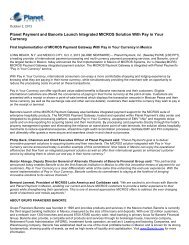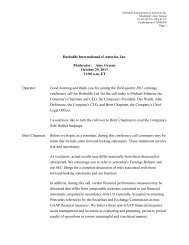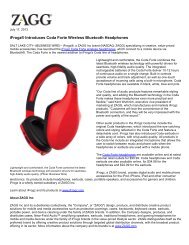Hypercom Corporation Annual Report - CiteSeer
Hypercom Corporation Annual Report - CiteSeer
Hypercom Corporation Annual Report - CiteSeer
You also want an ePaper? Increase the reach of your titles
YUMPU automatically turns print PDFs into web optimized ePapers that Google loves.
solution against payment card fraud. Several large transaction processors and acquirers in EMV based countries (particularly<br />
the United Kingdom) are considering rolling out E2EE solutions to securely encapsulate the EMV transaction messages.<br />
• Interoperability Standards. In the U.S., payment processors have two levels of certification, referred to as Class A and Class<br />
B. Class B certification ensures that an electronic payment system adheres to the payment processor’s basic functional and<br />
network requirements. Class A certification adds another stipulation that the payment processor will support the electronic<br />
payment system on its internal help desk systems. Obtaining these certifications can be costly and time intensive, and is<br />
required by U.S. payment processors. In other countries outside of the U.S., payment applications have to be certified with<br />
local banks, processors or card schemes. Electronic payment systems must also comply with evolving country-specific<br />
security regulations. Countries such as Australia, Canada, Germany, the Netherlands, New Zealand, Singapore, Sweden and<br />
Switzerland have particularly stringent and specific security standards. Electronic payment systems must also comply with<br />
recommendations of quasi-regulatory authorities and standard-setting committees, which address, among other things, fraud<br />
prevention, processing protocols and technologies utilized. New standards are continually being adopted as a result of<br />
worldwide fraud prevention initiatives, increasing the need for system compatibility and new developments in technology.<br />
These complex and evolving requirements will provide an opportunity for continuous replacement of outdated equipment<br />
with newly certified electronic payment systems.<br />
• Broadband & Internet Protocol. Internet Protocol (“IP”) connectivity provides faster transmission of transaction data at a<br />
lower cost, enabling more advanced payment and other value-added applications at the point of sale. Major<br />
telecommunications carriers have expanded their communications networks and lowered fees to allow more merchants to<br />
utilize IP networks cost effectively. The faster processing and lower costs associated with IP connectivity have opened new<br />
markets for electronic payment systems, many of which have previously been primarily cash-only industries such as quick<br />
service restaurants (“QSRs”).<br />
• Contactless. Contactless technology, based on the deployment of contactless cards or NFC-enabled mobile telephones,<br />
creates a convenient way to pay for goods and services. It is an emerging technology that is rapidly gaining acceptance due to<br />
its delivery of extremely fast transaction times, reduced waiting times and elimination of the need for paper signatures and<br />
receipts. It is especially suitable for access control and use in cafeterias, QSRs, gas stations and public transit systems.<br />
• Wireless. Wireless electronic payment solutions are being developed to increase transaction efficiency and mobility.<br />
Wireless terminals can provide consumers with additional security by allowing them to maintain control of their payment<br />
card at all times. Additionally, the cost per transaction using wireless terminals may be lower than that of wired terminals in<br />
regions burdened with high telecommunications costs such as Europe and Asia-Pacific. It also enables terminal deployment<br />
in those regions lacking an established landline telecommunications infrastructure. We provide IP, Code-Division Multiple<br />
Access (“CDMA”), General Packet Radio Service (“GPRS”), Bluetooth and Wi-Fi connectivity across our range of wireless<br />
products.<br />
• Debit. Debit is the dominant payment instrument in most international markets and is rapidly growing in the U.S. Debit<br />
cards allow banks to reach a wider population of potential cardholders, thereby increasing the number of transactions. The<br />
cost of a debit transaction is generally lower than that of a credit transaction and combined with PIN-based security or<br />
biometric technology, provides a solution that helps reduce fraud. As a consequence, electronic payment is now an affordable<br />
and convenient option in markets lacking a significant consumer credit base as well as for small ticket or lower margin<br />
merchants.<br />
• Emerging Regions and Markets. In the U.S. and Europe, consumer markets such as QSRs and unattended/self service have<br />
started using IP terminal devices. These lesser penetrated vertical markets represent a significant opportunity for us, as well<br />
as other geographies in each of our business segments, such as Brazil, China, Eastern Europe, India, Mexico and Russia,<br />
which are experiencing rapid growth in the usage of card-based payments. The increasing adoption of electronic payments in<br />
these regions is driven primarily by economic growth, improving telecommunications infrastructure development, strong<br />
support from governments seeking to increase sales tax collection, and the dramatic increase of wireless networks for voice<br />
and data communications.<br />
• Multiple Applications. In addition to payment, terminals have the capability to perform concurrent applications like loyalty,<br />
stored value, on-screen advertising, electronic signature capture, age identification, and benefits authorization and transfer.<br />
The secure integration of these applications along with payment processing provides a comprehensive solution that allows<br />
merchants a means of competitive differentiation, revenue enhancement and cost reduction.<br />
• Smartphone Based Terminals. With the increasing processing power and popularity of Smartphone and PDA devices in the<br />
hands of the small or occasional merchant, there is an emerging opportunity to enable these devices to accept card based<br />
- 5 -

















